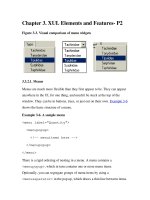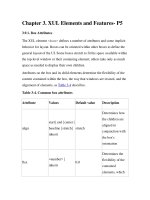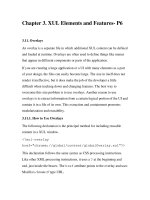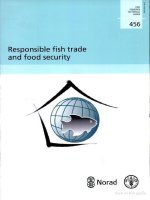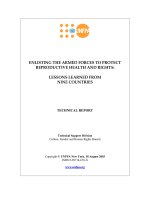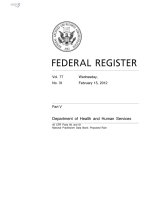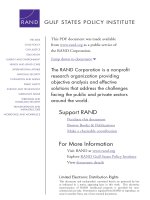elements and compounds lessons 4-5
Bạn đang xem bản rút gọn của tài liệu. Xem và tải ngay bản đầy đủ của tài liệu tại đây (9.99 MB, 23 trang )
Elements and Elements and
CompoundsCompounds
Lessons 4 – 5Lessons 4 – 5
CXECA08ARD501_LLR_CVb1 3CXECA08ARD501_LLR_CVb1 3 2/21/06 4:29:24 PM2/21/06 4:29:24 PM
Copyright © by Harcourt, Inc.
All rights reserved. No part of this publication may be reproduced or transmitted in
any form or by any means, electronic or mechanical, including photocopy, recording,
or any information storage and retrieval system, without permission in writing from the
publisher.
Requests for permission to make copies of any part of the work should be addressed to
School Permissions and Copyrights, Harcourt, Inc., 6277 Sea Harbor Drive, Orlando,
Florida 32887-6777. Fax: 407-345-2418.
HARCOURT and the Harcourt Logo are trademarks of Harcourt, Inc., registered in the
United States of America and/or other jurisdictions.
Printed in the United States of America
ISBN-13: 978-0-15-349189-4
ISBN-10: 0-15-349189-2
1 2 3 4 5 6 7 8 9 10 179 15 14 13 12 11 10 09 08 07 06
If you have received these materials as examination copies free of charge, Harcourt
School Publishers retains title to the materials and they may not be resold. Resale of
examination copies is strictly prohibited and is illegal.
Possession of this publication in print format does not entitle users to convert this
publication, or any portion of it, into electronic format.
CXECA08ARD501_LLR_CVb1 4CXECA08ARD501_LLR_CVb1 4 2/21/06 4:30:18 PM2/21/06 4:30:18 PM
Visit The Learning Site!
www.harcourtschool.com
Orlando
Austin
New York
San Diego
To r onto
London
Lesson 4
How Are Chemical and Physical Properties Used?. . . . . . 2
Lesson 5
What Are Chemical Reactions? . . . . . . . . . . . . . . . . . . . . 8
Elements and
Compounds
Lessons 4–5
CXECA08ARD5014-5_BLR_01 1CXECA08ARD5014-5_BLR_01 1 2/25/06 9:01:52 AM2/25/06 9:01:52 AM
VOCABULARY
chemical property
acid
base
4
4
4
Flammability, or the ability to
catch on fire, is one kind of
chemical property.
The juice in these oranges is a
weak acid.
How Are
How Are
Chemical
Chemical
and Physical
and Physical
Properties
Properties
Used?
Used?
2
CXECA08ARD5014-5_BLR_02 2CXECA08ARD5014-5_BLR_02 2 2/25/06 9:08:01 AM2/25/06 9:08:01 AM
This soap has the properties of a weak base.
3
CXECA08ARD5014-5_BLR_01 3CXECA08ARD5014-5_BLR_01 3 2/21/06 6:17:44 PM2/21/06 6:17:44 PM
4
READING FOCUS SKILL
MAIN IDEA AND DETAILS
The main idea is what the text is mostly about.
Details tell more about the main idea.
The main idea is that physical and chemical properties
are used in different ways. Look for
details about how
mixtures are separated
Separating Mixtures
Sometimes it is easy to
separate the parts of a mixture.
At other times, it is not so easy.
It would be easy to separate
raisins from flakes in cereal. It
would not be easy to separate
flour and sugar mixed together.
Physical properties can help
you separate mixtures. The
picture shows how to separate
a mixture of rocks, dirt, iron
and salt.
To separate a mixture of
rocks, dirt, iron and salt:
1. Screen out the rocks.
2. Use a magnet to take
away bits of iron. 3.
Pour water through a
filter to remove dirt. 4.
Boil the water. 5. Only
salt is left behind.
1
2
3
4
5
CXECA08ARD5014-5_BLR_01 4CXECA08ARD5014-5_BLR_01 4 2/21/06 6:18:14 PM2/21/06 6:18:14 PM
5
Chemical properties
can also be used to separate
mixtures. A chemical property describes a reaction. It shows
how substances react when they combine to make new
substances.
Most metals in nature are found in minerals. These minerals
are called ores. Ores are compounds.
The metal must be removed from the ore before it can be
used. Chemicals are used to do this. Then the metal can be
used.
How are physical properties used to separate
mixtures?
In nature, copper is
usually found combined
with oxygen or sulfur.
CXECA08ARD5014-5_BLR_01 5CXECA08ARD5014-5_BLR_01 5 2/21/06 6:18:29 PM2/21/06 6:18:29 PM
Identifying Elements and Compounds
Chemical properties help identify elements and compounds.
You can find out if a substance is an
acid
or a
base
. Litmus
paper is used. It has chemicals in it that change colors. An
acid
turns blue litmus paper red. A
base
turns red litmus paper blue.
Some acids and bases are stronger than others. Scientists
rank acids and bases on a scale. This scale, called the pH scale,
has numbers from 0 to 14. An acid has a pH of less than 7. A
base has a pH of more than 7.
Water and some other substances are neutral. They have a
pH of 7. They are neither acids nor bases.
6
10234567891011 12
A Battery acid is strong. It can have a pH of 0. Lemon drink has a
pH of about 2. Drain cleaners are stong bases. They have a pH of
about 10. Ammonia has a pH of about 11.
pH Scale
CXECA08ARD5014-5_BLR_01 6CXECA08ARD5014-5_BLR_01 6 2/21/06 6:18:35 PM2/21/06 6:18:35 PM
7
Complete this main idea statement.
1. Physical and chemical ______ help identify
elements and compounds.
Complete these detail statements.
2. ______ ______ changes colors when put into an
acid or a base.
3. An ______ turns blue litmus paper red.
4. A ______ turns red litmus paper blue.
Review
Review
Physical properties help identify substances. Metals can be
identified by their melting points. Texture is another physical
property. Some things are brittle. They break or crush easily.
Solubility also helps identify elements and compounds. Sugar
dissolves easily in water. Salt dissolves less easily.
Chemical properites can also be used to identify substances.
But, you have to change the substance itself.
What are three physical properties that help
identify substances?
salt sugar
Sugar dissolves more
easily in water than salt.
CXECA08ARD5014-5_BLR_01 7CXECA08ARD5014-5_BLR_01 7 2/21/06 6:18:48 PM2/21/06 6:18:48 PM
VOCABULARY
chemical reaction
reactant
product
salt
Rusting is one kind of
chemical reaction.
When combined, vinegar and
baking soda are reactants.
What Are
What Are
Chemical
Chemical
Reactions?
Reactions?
8
5
5
CXECA08ARD5014-5_BLR_02 8CXECA08ARD5014-5_BLR_02 8 2/25/06 9:08:10 AM2/25/06 9:08:10 AM
9
Carbon dioxide is a product. It
comes from combining baking
soda and vinegar.
Table salt is just one kind of salt.
CXECA08ARD5014-5_BLR_01 9CXECA08ARD5014-5_BLR_01 9 2/21/06 6:18:56 PM2/21/06 6:18:56 PM
10
READING FOCUS SKILL
COMPARE AND CONTRAST
You compare when you look at how things are alike.
You contrast when you look at how things are different.
Compare and contrast different chemical reactions.
Changing Properties
Paper tears. Glass breaks. Sugar dissolves in water. These
are physical changes. They are not chemical changes. In a
chemical change, the substance cannot be changed back
easily.
A
chemical reaction
is a chemical change. If you touch a
lit match to wood, the wood burns. When something burns,
it combines with oxygen.
This produces other
gases. You may not see
the gases. But you know
that something is gone.
You see the ashes.
When candles burn,
oxygen from the air
causes a chemical
change.
CXECA08ARD5014-5_BLR_10 10CXECA08ARD5014-5_BLR_10 10 2/21/06 6:20:23 PM2/21/06 6:20:23 PM
11
You can tell when a a chemical change takes place. You
know because the properties of the materials are different.
New substances with different properties have formed.
There are clues that tell you when a chemical change
is taking place. When you see bubbles after adding one
substance to another, this is a clue. When you see color
changes, this is another clue.
Compare and contrast physical and chemical
changes.
• made up of hydrogen and oxygen
• reacts with some metals to produce
bases
• reacts with few substances
• does not react with air
• reacts with ozone or sulfur to form
tarnish
• reacts easily with many substances
• reacts with oxygen to form the
minerals hematite and magnetite
• reacts with oxygen in presence of
water to form rust
• reacts with any liquid element
• reacts with any solid element
except gold and platinum
• reacts with oxygen to form sulfur
dioxide, a form of air pollution
Silver
Iron
Sulfur
• colorless
• odorless
• liquid at room
temperature
• boils at 100˚C
• melts at 0˚C
• shiny
• soft
• silver in color
• boils at 2163˚C
• melts at 962˚C
• shiny
• hard
• grayish silver in
color
• boils at 2861˚C
• melts at 1538˚C
• dull
• brittle
• yellow
• boils at 445˚C
• melts at 115˚C
Water
Chemical
Properties
Physical
Properties
CXECA08ARD5014-5_BLR_10 11CXECA08ARD5014-5_BLR_10 11 2/21/06 6:21:16 PM2/21/06 6:21:16 PM
12
Reactants and Products
Every chemical reaction begins with one or more
reactants
.
A reactant is one of the starting materials in a chemical reaction.
If an electric charge goes through water, bubbles form. The
bubbles are hydrogen and oxygen gas. The reactant is water.
Hydrogen and oxygen are
products
. They are the result of the
chemical reaction.
Sodium and chlorine are elements. Adding water to them
makes the sodium and chlorine react. The product of this
chemical reaction is sodium chloride. It is table salt.
Another reaction is an iron nail rusting. The iron reacts with
oxygen in the air. The iron and oxygen combine. They make
the product, iron oxide. You know iron oxide as rust. Rust has
different properties than iron or oxygen.
SODIUM
CHLORINE S
+
CXECA08ARD5014-5_BLR_12 12CXECA08ARD5014-5_BLR_12 12 2/21/06 7:37:37 PM2/21/06 7:37:37 PM
13
When silver tarnishes, it becomes silver sulfide. One reactant
is the element silver. The other reactant is the compound
hydrogen sulfide.
Compare and contrast reactants and products.
Silver reacts with hydrogen
sulfide in the air. This makes
silver sulfide, or tarnish.
SODIUMCHLORIDE
CRYSTAL
E LIGHT
AND
HEAT
B Sodium reacts with chlorine. Energy is given off as
heat and light. Sodium chloride—table salt—is made.
+
CXECA08ARD5014-5_BLR_12 13CXECA08ARD5014-5_BLR_12 13 2/21/06 7:38:07 PM2/21/06 7:38:07 PM
14
Making New Substances
Reactions of elements and compounds create all the kinds of
matter in the world. Sometimes a compound breaks apart to
make new substances. It breaks into its elements. In a chemical
change, water breaks into the elements hydrogen and oxygen.
In another kind of reaction, two elements combine. They
come together to make a compound. Hydrogen combines
with oxygen to make water. This is the opposite of the first
reaction.
Two Compounds React:
One compound dissolves
in water and makes a
clear solution. The other
dissolves and makes a
yellow solution. The two
solutions mix to form two
solids. One is red. The
other dissolves again. You
don’t see it.
CXECA08ARD5014-5_BLR_14 14CXECA08ARD5014-5_BLR_14 14 2/25/06 11:39:04 AM2/25/06 11:39:04 AM
15
A Baking bread is a chemical change.
A new substance is formed.
Elements and compounds combine in other ways to form
new compounds. Many carbon compounds have long chains
of molecules. They look like paper clips linked together. The
chains are found in plastics, proteins, and DNA.
Compare ways that compounds combine.
CXECA08ARD5014-5_BLR_10 15CXECA08ARD5014-5_BLR_10 15 2/21/06 6:22:49 PM2/21/06 6:22:49 PM
16
Cooking may change food. But it
does not create or destroy it.
Conservation of Mass
During a chemical change, new substances form. These
substances are not new matter. The same atoms that were in
the reactants are in the products. They are just combined in
different ways.
You can measure the mass of the sodium and chlorine gases
used in a reaction. After they have changed to salt, you can
measure the salt’s mass. The masses will be the same. No new
matter has been made. No matter was destroyed. This is called
the Law of Conservation of Mass.
CXECA08ARD5014-5_BLR.indd 16CXECA08ARD5014-5_BLR.indd 16 10/23/06 2:22:40 PM10/23/06 2:22:40 PM
17
If you burned a marshmallow in a sealed box, you would
not lose matter. You could measure mass before and after your
test. The marshmallow is smaller but gases were created.
In any chemical reaction, no new matter is formed. Matter is
conserved. The amount of matter remains the same.
Compare the products of a chemical reaction to the
masses of the reactants.
A glow stick does not gain or lose mass when a
chemical reaction makes it glow.
CXECA08ARD5014-5_BLR_17 17CXECA08ARD5014-5_BLR_17 17 2/27/06 10:08:00 AM2/27/06 10:08:00 AM
Salts
Litmus paper shows when something is an acid or a base.
Orange juice is an acid. So is the vinegar used in salad
dressing.
Household products like ammonia and soap are bases. So
are detergent, shampoo, and drain cleaner. Strong bases are
dangerous. So are strong acids. They can burn skin.
When you add vinegar and baking soda, you get bubbles.
A chemical property of acids and bases is that they react with
one another.
18
A car battery has
very strong acid in
it. This helps make
electricity to start
the car.
CXECA08ARD5014-5_BLR_10 18CXECA08ARD5014-5_BLR_10 18 2/21/06 6:23:59 PM2/21/06 6:23:59 PM
Salt
is the product formed when an acid and a base
react. There are many salts. Table salt is just one kind
of salt.
Most salts are made when strong acids react with
strong bases. Salts also form when some metals react
with strong acids.
Contrast two household products that are acids
and bases.
19
Complete these compare and contrast statements.
1. In ______ changes, the properties of the materials
change.
2. In one kind of chemical reaction, a compound
breaks apart. In another, ______ combine.
3. ______ changes don’t create bubbles, but chemical
changes do.
4. ______ are present at the start of a chemical
reaction, and products are present at the end.
Review
Review
Baking soda is a base.
CXECA08ARD5014-5_BLR_10 19CXECA08ARD5014-5_BLR_10 19 2/21/06 6:24:11 PM2/21/06 6:24:11 PM
20
GLOSSARY
acid (AS
•
id) A chemical compound that turns blue litmus
paper red and has a pH of less than 7.
base (BAYS) A chemical compound that turns red litmus paper
blue and has a pH of more than 7.
chemical property (KEM
•
ih
•
kuhl PRAP
•
er
•
tee) A property
that involves the ability of a substance to react with other
materials and form new substances.
chemical reaction (KEM
•
ih
•
kuhl re
•
AK
•
shuhn) A change in
which one or more new substances are formed.
product (PRAHD
•
uhkt) A substance that is formed by a
chemical reaction.
reactant (ree
•
AK
•
tuhnt) A substance that changes during a
chemical reaction.
salt (
SAWLT) A substance that is made by combining an acid
and a base.
CXECA08ARD5014-5_BLR_20 20CXECA08ARD5014-5_BLR_20 20 2/21/06 6:44:15 PM2/21/06 6:44:15 PM
School-Home Connection
Talk to your family about acids and bases. Show them products in your
home that are acids. Show them products that are bases. Tell them
what happens when you mix an acid and a base.
Hands-On Activity
1. Identify two examples of different chemical reactions.
2. Make a list that describes the changes that take place when each
chemical reaction occurs.
3. Discuss your list with someone in your class.
Think About the Reading
1. You learned about the chemical properties of some common
substances. Are there other substances you would like to learn
about?
2. Where can you go to find out about other substances and their
chemical properties?
CXECA08ARD501_LLR_CVb1 5CXECA08ARD501_LLR_CVb1 5 2/21/06 4:30:19 PM2/21/06 4:30:19 PM
